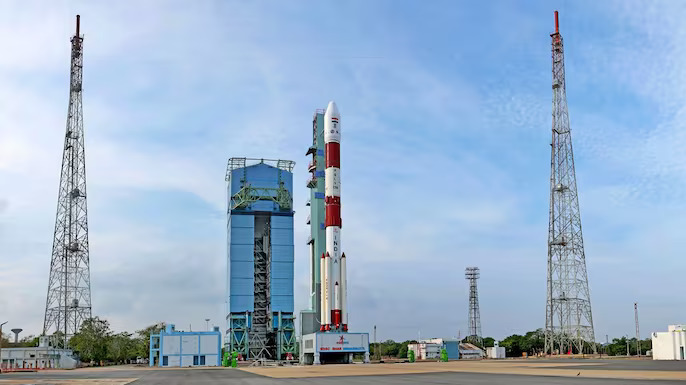The Indian Space Research Organisation (ISRO) has once again demonstrated its prowess in space exploration with the successful launch of the PSLV-XL carrying the Proba-3 mission. This milestone reinforces ISRO’s reputation as a reliable and cost-effective launch provider and underscores international collaboration in space technology. Here’s a detailed look at this remarkable event. ISRO’s PSLV-XL Successfully launches Proba-3 Mission marking another significant milestone in India’s space program.
India’s science minister, Dr. Jitendra Singh, who oversees the government’s space operations, congratulated ISRO on its “serial” successes, stating that Proba-3 is the first precision formation flying mission in history. The study of the solar corona, the outermost and hottest layer of the Sun’s atmosphere, makes this mission special. The launch was postponed by 24 hours, minutes before the lift-off yesterday as the European Space Agency’s satellite had an ‘anomaly’. But a day later the PSLV had an on-dot lift-off. The PSLV rocket had no issues and the ‘anomaly’ was detected in the passenger satellite, which was resolved by the ESA team.

On December 5, 2024, the Indian Space Research Organisation (ISRO) successfully launched the Polar Satellite Launch Vehicle-XL (PSLV-XL) carrying the European Space Agency’s (ESA) Proba-3 mission from the Satish Dhawan Space Centre in Sriharikota, Andhra Pradesh. This mission marks a significant milestone in international collaboration and technological advancement in space exploration.
The PSLV-XL rocket, known for its enhanced payload capacity due to its extended strap-on boosters, lifted off at precisely 4:04 PM IST. The mission aimed to deploy ESA’s Proba-3 satellites into a highly elliptical orbit. The Proba-3 mission consists of two satellites, the Occulter Spacecraft (OSC) and the Coronagraph Spacecraft (CSC), designed to study the Sun’s outer atmosphere, the corona, by creating an artificial solar eclipse.
The PSLV-XL: A Proven Workhorse
The Polar Satellite Launch Vehicle (PSLV) in its XL configuration is a trusted member of ISRO’s fleet. This variant features six extended solid rocket boosters that provide enhanced thrust during liftoff. Known for its versatility and precision, the PSLV-XL has been the backbone of numerous missions, including Chandrayaan-1, Mangalyaan, and satellite deployments for global clients.
- Key Features of PSLV-XL:
- Payload capacity to Low Earth Orbit (LEO): 1,800 kg
- Height: 44 meters
- Four-stage propulsion system: alternating solid and liquid stages for optimal performance.
For this mission, the PSLV-XL was tailored to meet the specific orbital requirements of Proba-3, a European Space Agency (ESA) mission.
What is Proba-3?
Proba-3 (Project for On-Board Autonomy-3) is an ambitious ESA mission aimed at demonstrating precision formation flying in space. Comprising two small satellites, Proba-3 is designed to work in tandem to create an artificial solar eclipse, enabling detailed observations of the Sun’s corona. This region is usually obscured by the Sun’s glare.
Key Objectives of Proba-3:
- Formation Flying Technology:
- The two satellites will maintain a precise distance of 150 meters apart.
- This technology can revolutionize how satellites collaborate in space for scientific and commercial applications.
- Solar Corona Study:
- Using one satellite as a coronagraph (an instrument to block the Sun’s direct light) and the other as an observer, Proba-3 will capture unprecedented details of the solar corona.
- Insights gained could improve understanding of solar winds and space weather.
- Technological Advancements:
- Proba-3 will validate autonomous spacecraft operation, enabling future missions to conduct coordinated maneuvers without ground intervention.
Proba-3 Mission Objectives
The Proba-3 mission is a unique space experiment focused on studying solar corona through precise formation flying. The mission consists of two spacecraft that will work in tandem:
- A coronagraph spacecraft
- An occulter spacecraft
These two satellites will maintain an extremely precise formation, creating an artificial eclipse to study the sun’s outer atmosphere in unprecedented detail. The mission aims to:
- Capture high-resolution images of the solar corona
- Study the sun’s magnetic field and plasma dynamics
- Advance our understanding of solar physics
Launch Details
- Date and Time: The launch occurred on [December 5].
- Launch Site: Satish Dhawan Space Centre, Sriharikota, India.
- Payload: Proba-3 along with other auxiliary payloads from international customers.
- Orbit: Proba-3 was deployed into a Highly Elliptical Orbit (HEO) suitable for its experimental objectives.
The PSLV-XL’s flawless performance during liftoff and payload deployment highlights ISRO’s reliability in handling complex missions.
Global Collaboration and its Significance
The Proba-3 mission exemplifies international cooperation in space exploration. ESA’s collaboration with ISRO reflects the increasing reliance on India’s launch capabilities for global missions. This synergy not only reduces costs but also accelerates scientific discovery.
For ISRO, such partnerships provide access to advanced technologies and research opportunities, fostering innovation within India’s growing space ecosystem.
Important Facts About ISRO’s PSLV-XL Proba-3 Mission
| Category | Details |
|---|
| Launch Vehicle | PSLV-XL (Polar Satellite Launch Vehicle – XL configuration) |
| Vehicle Height | 44.4 meters |
| Payload Capacity | Up to 1,800 kg to Low Earth Orbit (LEO) |
| Stages | Four-stage propulsion system (solid and liquid alternation) |
| Launch Site | Satish Dhawan Space Centre (SDSC), Sriharikota, India |
| Mission Name | Proba-3 (Project for On-Board Autonomy-3) |
| Developer | European Space Agency (ESA) |
| Mission Objectives | – Demonstrate precision formation flying technology – Study the Sun’s corona |
| Payload Configuration | Two satellites working in tandem to create an artificial solar eclipse |
| Formation Flying Distance | 150 meters between the two satellites |
| Orbit Type | Highly Elliptical Orbit (HEO) |
| Technology Highlights | – Autonomous satellite operation – High-precision deployment |
| Scientific Purpose | Study the solar corona, improve understanding of solar activity, and forecast space weather |
| Secondary Payloads | Additional satellites from international clients |
| Global Collaboration | Partnership between ISRO and ESA |
| Launch Impact | Strengthens ISRO’s reputation as a reliable and cost-effective global launch provider |
| Applications | – Solar research – Autonomous multi-satellite coordination – Future telescopic missions |
| Key Achievements | Enhanced satellite autonomy, advanced formation flying technology |
Implications for Future Space Exploration
The successful launch of Proba-3 opens new avenues for technological and scientific advancements:
- Enhanced Spacecraft Autonomy: The autonomous formation-flying techniques tested by Proba-3 could be applied to future missions, including space telescopes and Earth observation constellations.
- Solar Research: Detailed studies of the Sun’s corona will improve predictions of solar storms and safeguard satellites and Earth-based technologies.
- Strengthened ISRO-ESA Relations: This mission lays the groundwork for deeper collaborations in space exploration and research.
The launch of Proba-3 by ISRO’s PSLV-XL is a testament to India’s growing influence in the global space industry. By successfully delivering a cutting-edge ESA mission, ISRO has showcased its technological capabilities and commitment to advancing space science.
ISRO’s successful launch of the Proba-3 mission using the PSLV-XL rocket is more than just a technical achievement. It represents a testament to India’s growing capabilities in space technology, scientific research, and international collaboration. As we continue to push the boundaries of space exploration, missions like Proba-3 remind us of the incredible potential of human curiosity and technological innovation.
As space agencies worldwide increasingly collaborate, missions like Proba-3 signify a unified effort toward unraveling the mysteries of our universe. For India, this launch reinforces its position as a key player in the evolving space economy.
What are your thoughts on ISRO’s remarkable achievement with Proba-3? Share your perspectives below!
Read Also
- BSNL Direct to Device Satellite Service
- Why Earth’s Magnetic Pole Is Moving and Its Impacts
- Top Research Centers in India
- World’s Most Expensive Experiments
- UV Scuti: The Cosmic Titan Among Stars
Frequently Asked Questions (FAQs)
A. The PSLV-XL is an enhanced variant of ISRO’s Polar Satellite Launch Vehicle (PSLV), equipped with six extended solid rocket boosters for increased thrust. It is designed for launching heavier payloads and has been a reliable vehicle for numerous significant missions, including Chandrayaan-1 and Mangalyaan.
A. Proba-3 (Project for On-Board Autonomy-3) is a European Space Agency (ESA) mission focused on demonstrating precision formation flying in space. It consists of two satellites that work together to create an artificial solar eclipse, enabling detailed studies of the Sun’s corona.
A. The mission is critical for testing advanced technologies like autonomous formation flying, which can revolutionize future multi-satellite missions. Additionally, the study of the Sun’s corona could enhance our understanding of solar activity and its impact on space weather.
A. Height: 44.4 meters
Payload Capacity: Up to 1,800 kg to Low Earth Orbit (LEO)
Stages: Four (alternating solid and liquid propulsion systems)
Reliability: Proven track record with over 50 successful launches.
A. The satellites were deployed into a Highly Elliptical Orbit (HEO), which is ideal for their experimental objectives, including formation flying and solar corona observations.
A. This mission strengthens ISRO’s reputation as a reliable and cost-effective launch provider, enhances its global partnerships, and demonstrates its capability to handle complex international missions.
A. Proba-3 will provide detailed observations of the Sun’s corona, contributing to our understanding of solar winds, space weather, and their impact on Earth. The mission also validates new technologies that can enhance future space missions.

Turning Points: A Journey Through Challenges
The inspiring sequel to Wings of Fire. Over 3 lakh copies sold.’It was like any other day on the Anna University campus in Chennai. As I was returning to my room in the evening, the vice-chancellor, Prof. A. Kalanidhi, fell in step with me. Someone had been frantically trying to get in touch with me through the day, he said. Indeed, the phone was ringing when I entered the room.





